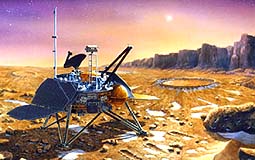| . |  |
. |
|
Pasadena - January 25, 2000  Mission managers have decided to send another set of commands to Mars to investigate the possibility that a signal detected by a radio dish at California's Stanford University came from Mars Polar Lander. Mission managers have decided to send another set of commands to Mars to investigate the possibility that a signal detected by a radio dish at California's Stanford University came from Mars Polar Lander.The commands were sent at 10 a.m. PST today. They will instruct the lander, if it is operating, to send a signal directly to Earth to the antenna at Stanford on Wednesday, January 26, at approximately 1 p.m. PST. The Stanford receiving station will listen again during the window on Wednesday to see if it picks up a signal that could originate from Mars. The results of this test will not be immediate and it will take the team several days to process the data. Mission managers sent commands several times in December and January instructing Polar Lander to send a radio signal to the 45-meter (150-foot) antenna at Stanford. Although no signal was detected in real-time, the team in charge of the Stanford antenna says that after additional processing of the data they may have detected a signal that could have come from Mars during tests on December 18 and January 4. Because the signal was so weak, it took several weeks for the Stanford team to process their data and reach this conclusion. "This week's test is a real long-shot, and I wouldn't want to get anyone too excited about it," said Richard Cook, Polar Lander project manager at NASA's Jet Propulsion Laboratory, Pasadena, CA. "The signal that the Stanford team detected is definitely artificial, but there are any one of a number of places it could have originated on or near Earth. Still, we need to conduct this test to rule out the possibility that the signal could be coming from Polar Lander." If in fact the signal were from Polar Lander, two failures would have had to occur. First, the lander's X-band radio that it would use to transmit directly to Earth would have to be broken. Second, there would have to be a problem somewhere in the relay with Mars Global Surveyor that prevented the signal from being picked up and relayed by the orbiter. It is unlikely that a broken transmitter on the lander could be fixed, and unclear whether a problem with the relay could be resolved. Although the Stanford data from the previous tests took several weeks to process, the team expects to have results within several days now that they know what they are looking for. Even if the signal were coming from the lander, there is little hope that any science could be returned. However, it would give the team a few more clues in trying to eliminate possible failure modes.
EARTH INVADES MARS
|
| |||||||||
| The content herein, unless otherwise known to be public domain, are Copyright 1995-2016 - Space Media Network. All websites are published in Australia and are solely subject to Australian law and governed by Fair Use principals for news reporting and research purposes. AFP, UPI and IANS news wire stories are copyright Agence France-Presse, United Press International and Indo-Asia News Service. ESA news reports are copyright European Space Agency. All NASA sourced material is public domain. Additional copyrights may apply in whole or part to other bona fide parties. Advertising does not imply endorsement, agreement or approval of any opinions, statements or information provided by Space Media Network on any Web page published or hosted by Space Media Network. Privacy Statement All images and articles appearing on Space Media Network have been edited or digitally altered in some way. Any requests to remove copyright material will be acted upon in a timely and appropriate manner. Any attempt to extort money from Space Media Network will be ignored and reported to Australian Law Enforcement Agencies as a potential case of financial fraud involving the use of a telephonic carriage device or postal service. |